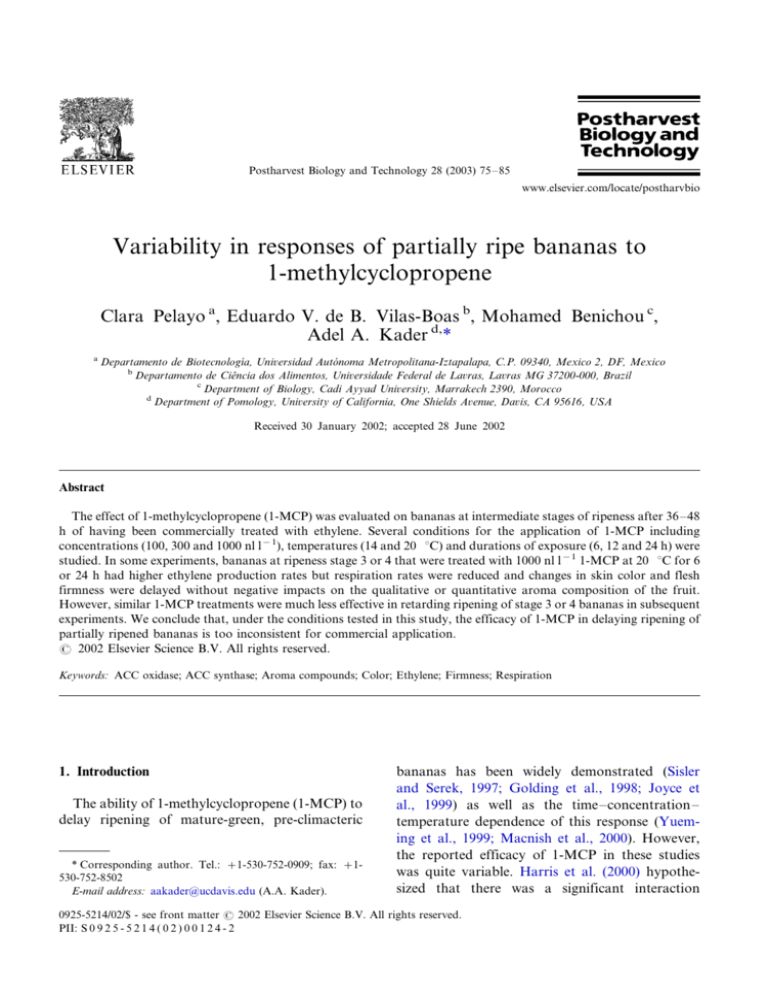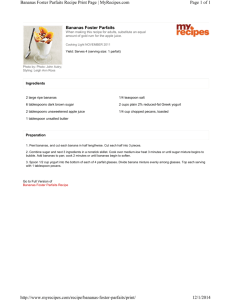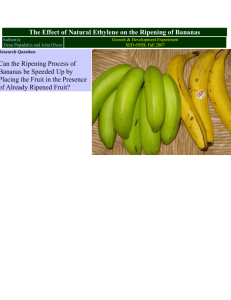
Postharvest Biology and Technology 28 (2003) 75 /85
www.elsevier.com/locate/postharvbio
Variability in responses of partially ripe bananas to
1-methylcyclopropene
Clara Pelayo a, Eduardo V. de B. Vilas-Boas b, Mohamed Benichou c,
Adel A. Kader d,*
a
Departamento de Biotecnologı́a, Universidad Autónoma Metropolitana-Iztapalapa, C.P. 09340, Mexico 2, DF, Mexico
b
Departamento de Ciência dos Alimentos, Universidade Federal de Lavras, Lavras MG 37200-000, Brazil
c
Department of Biology, Cadi Ayyad University, Marrakech 2390, Morocco
d
Department of Pomology, University of California, One Shields Avenue, Davis, CA 95616, USA
Received 30 January 2002; accepted 28 June 2002
Abstract
The effect of 1-methylcyclopropene (1-MCP) was evaluated on bananas at intermediate stages of ripeness after 36 /48
h of having been commercially treated with ethylene. Several conditions for the application of 1-MCP including
concentrations (100, 300 and 1000 nl l 1), temperatures (14 and 20 8C) and durations of exposure (6, 12 and 24 h) were
studied. In some experiments, bananas at ripeness stage 3 or 4 that were treated with 1000 nl l 1 1-MCP at 20 8C for 6
or 24 h had higher ethylene production rates but respiration rates were reduced and changes in skin color and flesh
firmness were delayed without negative impacts on the qualitative or quantitative aroma composition of the fruit.
However, similar 1-MCP treatments were much less effective in retarding ripening of stage 3 or 4 bananas in subsequent
experiments. We conclude that, under the conditions tested in this study, the efficacy of 1-MCP in delaying ripening of
partially ripened bananas is too inconsistent for commercial application.
# 2002 Elsevier Science B.V. All rights reserved.
Keywords: ACC oxidase; ACC synthase; Aroma compounds; Color; Ethylene; Firmness; Respiration
1. Introduction
The ability of 1-methylcyclopropene (1-MCP) to
delay ripening of mature-green, pre-climacteric
* Corresponding author. Tel.: /1-530-752-0909; fax: /1530-752-8502
E-mail address: aakader@ucdavis.edu (A.A. Kader).
bananas has been widely demonstrated (Sisler
and Serek, 1997; Golding et al., 1998; Joyce et
al., 1999) as well as the time /concentration /
temperature dependence of this response (Yueming et al., 1999; Macnish et al., 2000). However,
the reported efficacy of 1-MCP in these studies
was quite variable. Harris et al. (2000) hypothesized that there was a significant interaction
0925-5214/02/$ - see front matter # 2002 Elsevier Science B.V. All rights reserved.
PII: S 0 9 2 5 - 5 2 1 4 ( 0 2 ) 0 0 1 2 4 - 2
76
C. Pelayo et al. / Postharvest Biology and Technology 28 (2003) 75 /85
between the effectiveness of 1-MCP and the
maturity of bananas; they found that 500 nl l 1
of 1-MCP at 20 8C for 24 h was more effective in
delaying ripening as maturity progressed from 71
to 156/173 days after bunch emergence, although
the absolute time for bananas to ripen decreased
from 40 to 28 days, respectively, at 20 8C in a
continuous air flow containing 0.1 ml l1 of
ethylene.
Commercially, once bananas are induced to
ripen with ethylene, their marketing life is only
about 3/5 days depending on ethylene treatment
conditions and holding temperature after treatment. A method to slow down the ethyleneinduced ripening process has economical significance for distribution centers and supermarkets.
Cooling to 14 8C and modified atmosphere
packaging (MAP) has been shown to be a promising procedure for this purpose (Gorny and Kader,
personal communication), but bananas have to be
repacked after the ethylene treatment into the
polymeric film within which the appropriate MA
will be established. Fumigation with 1-MCP seems
to be a more convenient method since fruit
repacking would not be required. The number of
studies dealing with the effect of 1-MCP on
retarding ripening of partially ripe bananas is
limited (Joyce et al., 1999; Yueming et al., 1999)
and no studies have been reported about the effect
of 1-MCP on specific stages of ripeness of bananas
commercially treated with ethylene. Joyce et al.
(1999) found that banana ripening induced by
propylene, an ethylene analog, can be delayed by
exposure to 15 ml l 1 of 1-MCP at 20 8C for 12 h.
However, the 1-MCP treatment was less effective
as propylene-induced ripening progressed,
although it was able to maintain the eating-ripe
condition of fruits for a longer time than the
control treatment. Similarly, Yueming et al. (1999)
found that 1-MCP (in a concentration range 0.01 /
10 ml×/l 1 at 20 8C for 12 h) applied after 1 day of
ethylene treatment slowed down the ripening of
bananas, but it was ineffective when applied 3 or 5
days after ethylene treatment.
The purpose of this study was to evaluate the
efficacy of 1-MCP on ripening associated changes
of bananas at selected stages of ripeness after the
commercial application of ethylene.
2. Materials and methods
2.1. Experimental setup
Fruit were obtained from a wholesale produce
distributor in Sacramento, CA. Bananas were
sorted to eliminate the damaged fruit and to
obtain the samples of uniform ripeness according
to the standard banana ripening color chart. Three
replicates of three clusters, containing three to four
fingers per cluster, were used per treatment in all
experiments. In experiment 1, 100, 300 or 1000 nl
l1 1-MCP was applied on stage 3 bananas for 24
h at 20 8C. In experiment 2, stages 3 /4 bananas
were fumigated with 1000 nl l1 1-MCP at 20 8C
for 6 or 24 h. Treatments of stage 4 bananas with
1000 nl l 1 1-MCP at 14 8C were for 6 h in
experiment 3 and 12 and 24 h in experiment 4. In
experiment 5, stages 2, 3 and 4 bananas were
subjected to 1000 nl l 1 1-MCP for 24 h at 20 8C.
Before 1-MCP was applied, fruit were equilibrated
to the indicated temperature for every treatment.
In all experiments, 1-MCP was applied by injecting
a measured volume of a stock dilution into 10 l
sealed glass jars. Concentrations of 1-MCP were
calculated based on the free space volume of every
jar and verified by flame ionization gas chromatography (Carle gas chromatograph, Model 211; EG
& E Chandler Engineering, Tulsa, OK) using an
isothermal separation (80 8C) on a 610 /3.2 mm
stainless steel column packed with 60/80 mesh
Porapak Q (Supelco, Bellefonte, PA). Injector and
detector temperatures were set at 80 8C and
nitrogen at a flow rate of 25 ml min 1 was used
as a carrier gas. Isobutylene was used as the
standard gas to prepare the calibration curve.
After 1-MCP treatments, fruit were ventilated
and kept in sealed glass jars with a continuous
flow rate of air (free of ethylene) to maintain /
90% relative humidity and prevent CO2 accumulation above 0.2%. Fruit in glass jars were kept at
20 8C until they reached ripeness stage 7.
2.2. Respiration and ethylene production rates
Three samples of 10 and 1 ml withdrawn daily
from the headspace of every jar kept at 20 8C
were used to analyze carbon dioxide and ethylene
C. Pelayo et al. / Postharvest Biology and Technology 28 (2003) 75 /85
production, respectively. Carbon dioxide was
quantified by a Horiba Infrared Gas Analyzer,
Model PIR-2000R (Horiba Instruments, Inc.,
Irvine, CA) and ethylene by a gas chromatograph
(EG & E Chandler Engineering) equipped with a
flame ionization detector and a packed alumina
column. Injector, detector and oven temperature
were set at 80 8C and the carrier gas was nitrogen
at 25 ml min 1. Based on areas of standard gases,
concentrations of carbon dioxide and ethylene
were calculated.
2.3. Color and firmness
Ten fingers per replicate were used to evaluate
external skin color visually by the standard banana
color chart (von Loesecke, 1950) or objectively, on
opposite sides of every fruit, by a Minolta Chroma
meter, Model CR-300 (Minolta, Ramsey, NJ).
Color space a* and b * parameters were used to
calculate the hue angle (h /arctan(b */a *)). Crosssections from the middle part of the same fruit
were used to measure flesh firmness by a University of California Firmness Tester (Western
Industrial Supply, San Francisco, CA) fitted with
an 8 or a 3 mm probe. The remaining crosssections of fruit were frozen in liquid nitrogen,
homogenized in a blender in the presence of liquid
nitrogen to obtain a fine powder and stored at /
80 8C until the activity of 1-aminocyclopropane1-carboxylic acid (ACC) synthase and ACC oxidase and the concentrations of aroma compounds
were analyzed.
2.4. ACC synthase and ACC oxidase activities
Samples of banana powder were used to measure the activities of ACC synthase and ACC
oxidase according to the methods previously
described by Gorny and Kader (1996). The protein
content was measured by the Bradford (1976)
method by using the Bio-Rad reagent and bovine
serum albumin as standard.
2.5. Aroma compounds
Frozen banana powder (0.5 g) was placed in a
crimp-seal 16 ml vial. To avoid the generation of
77
artifacts and limit changes in aroma compounds
by enzymatic and chemical reactions, immediately
after the powder was thawed at room temperature
or before thawing was completed, 4.5 ml of a
NaOH/EDTA solution was added to obtain a
final pH of 6.2 and a 50 mM concentration of the
chelating agent. To facilitate the release of aroma
compounds, 1.5 g of NaCl was also added to every
sample. Vials were sealed with a black Viton
septum and 20 mm crimp caps, agitated for 1
min and analyzed by a headspace-solid phase
microextraction (SPME) technique using a GC /
mass spectrometer. A Varian 8200 cx autosampler
(Walnut Creek, CA) mounted to a HP 5890 GC
(Avondale, PA) paired with a HP5971 mass
selective detector (with an electronic upgrade to a
Model 5972) was the analytical system. This
system was operated by HP MSD CHEMSTATION
software. The GC oven was fitted with a 60 m /
0.32 mm ID and 1 mm film thickness DB-Wax
capillary column (J&W Scientific, Folsom, CA).
The temperature program was 50 8C held for 1
min, then increased to 110 8C at a 5 8C min1
and to a 180 8C at 20 8C min1 and finally held
for 9 min. The injector temperature was held at
200 8C. The autosampler was fitted with a 65 mm
Carbowax Divinylbenzene SPME fiber (Supelco,
Bellefonte, PA). The autosampler was programmed for an 11 min cycle; 10 min adsorption
time for sampling the headspace and 1 min for
desorption in the GC injector. Headspace samplings were done at 25/30 8C. Identification of
aroma compounds was initially accomplished by
matching mass spectra with library values. Confirmation of the identity and quantification of the
major volatiles were performed by trapping the
volatiles from the headspace of standard aqueous
solutions, containing 280 nl l1 of 4-heptanone as
internal standard, by the SPME fiber under the
same conditions as those used for the banana flesh
samples and by comparing areas with those of
analytes. When identification of aroma compounds was only accomplished by matching mass
spectra with library values, quantification was
carried out by comparing peak areas of analytes
to that of 4-heptanone added at 280 nl l 1 as
internal standard to the banana sample.
78
C. Pelayo et al. / Postharvest Biology and Technology 28 (2003) 75 /85
Exposure to 1-MCP delayed changes in skin
color and flesh softening of bananas and the
magnitude of this effect was dependent on concentration, but not on duration of exposure. A
decrease in hue angle (h ), representing a change in
peel color from green to yellow, was observed in
both control and 1-MCP-treated bananas kept at
20 8C, but a slower rate of this decrease in h value
was evident only in 300 and 1000 nl l1 1-MCPtreated fruit without significant differences between these two concentrations (Fig. 1A). Fruit
exposed to 1000 nl l 1 1-MCP for 6 or 24 h did
not show differences in skin color (h -values), but
significant differences were found between control
and 1-MCP-treated fruit (Fig. 1B).
Similarly, a difference in flesh firmness between
control and 1000 nl l1 1-MCP-treated bananas
was observed (Fig. 2A) and no significant differences in flesh firmness between fruit exposed to
1000 nl l1 1-MCP for 6 or 24 h were found (Fig.
2B).
Changes in respiration rate at 20 8C were
similar in both control and 1000 nl l 1 1-MCPtreated bananas. However, the rate of respiration
was lower in 1-MCP-treated bananas than in
control fruit (Fig. 3A). In contrast, ethylene
production was higher in 1000 nl l 1 1-MCPtreated than in control fruit (Fig. 3B). Similar
results were reported by Golding et al. (1999) who
speculated that 1-MCP may block the normal
feedback regulation of ethylene production and
presumably the transcription of ACC synthase
may be enhanced or the malonylation of its
substrate ACC may be prevented. An increase in
Fig. 1. Skin color of bananas (means of h -values9/SD) treated
at 20 8C with different concentrations (nl l 1) of 1-MCP for
24 h (A) and at 1000 nl l 1 for 6 or 24 h (B) and stored at
20 8C.
Fig. 2. Flesh firmness (means9/SD) of bananas treated with
1000 nl l 1 1-MCP at 20 8C for 24 h (A) and for 6 or 24 h (B)
and stored at 20 8C. Firmness was measured with an 8 mm
probe.
2.6. Statistical analysis
SAS system version 7.0 (SAS Institute, Inc.,
Cary, NC) was used to perform analysis of
variance and obtain LSD (5%) values of each of
the main effects.
3. Results and discussion
3.1. Experiments 1 and 2
C. Pelayo et al. / Postharvest Biology and Technology 28 (2003) 75 /85
Fig. 3. Respiration rate (A) and ethylene production (B) of
bananas treated with 1000 nl l 1 1-MCP at 20 8C for 24 h and
stored at 20 8C.
Fig. 4. Activities of ACC synthase (A) and ACC oxidase (B)
(means9/SD) of bananas treated with 1000 nl l 1 1-MCP at
20 8C for 24 h and stored at 20 8C.
79
the activity of ACC synthase in 1-MCP-treated
bananas was observed only on day 6 (Fig. 4A)
probably due to the fact that this enzyme has a
rapid turnover rate (Kim and Yang, 1992). An
increase in the activity of ACC oxidase in control
and to a greater extent in bananas treated with
1000 nl l 1 1-MCP was observed during storage at
20 8C (Fig. 4B). Moya-León and John (1994)
reported an increase in the in vivo ACC oxidase
activity in both peel and pulp of bananas up to 5
days at 20 8C after being treated with 60 ml l1
ethylene.
Qualitatively, the only aroma compounds detected in bananas at stage 3 of ripeness before the
1-MCP treatment were the aldehyde(E) 2-nonenal,
which is present in high levels in immature fruit,
and the C6 aldehydes hexanal and (E) 2-hexenal,
which are important constituents of climacteric
and post-climacteric bananas (Tressl and Drawert,
1973). These compounds contribute to the grassy
or herbaceous aromatic notes typically detected in
green fruit (McCarthy et al., 1963). When bananas
ripened, esters become an important fraction of
their aroma profile and the same aroma compounds were present in 1000 nl l1 1-MCP-treated
and control fruit (Table 1). In addition to C6
aldehydes, the amyl esters (2-pentylacetate or
amylacetate; 3-methylbutylacetate or isoamylacetate; 3-methylbutylbutyrate or isoamylbutyrate;
and the 3-methylbutyl, 3-methylbutyrate or isoamylisovalerate), responsible for the banana-like
flavor, and the esters butylacetate, hexylacetate
and butylbutyrate, with distinctive fruity notes,
were present in both control and 1-MCP-treated
bananas.
Quantitatively, no differences in the total
amount of aroma compounds and in the level of
the impact aroma compound isoamylacetate, between control and 1000 nl l1 1-MCP-treated fruit
were detected during storage at 20 8C (Fig. 5A
and D). Also, the total level of amyl esters was
essentially the same in both control and 1-MCPtreated bananas (6013 and 6452 nl l 1, respectively) after 8 days at 20 8C. However, a higher
level of C6 aldehydes was detected on day 8 and a
lower concentration of esters on day 3 in the 1000
nl l 1 1-MCP bananas (Fig. 5B and C), indicating
C. Pelayo et al. / Postharvest Biology and Technology 28 (2003) 75 /85
80
Table 1
Aroma compounds identified in control and 1-MCP-treated (1000 nl l 1 at 20 8C for 24 h) bananas
Aldehydes
Esters
Acetates
Butyrates
Others
2-Methylpropylacetate
Butylbutyrate
1-Methylbutyl, 2-methylpropanoate
(E) 2-hexenal
2-Pentylacetate
3-Methylbutylbutyrate
Methyloctanoate
(E) 2-nonenal
Butylacetate
3-Methylbutylacetate
2-Heptylacetate
Hexylacetate
3-Methylbutyl, 3-methylbutyrate
Octylbutyrate
Hexanal
a slight delaying effect of 1-MCP on the production of volatiles.
3.2. Experiments 3, 4 and 5
In experiment 3, we selected bananas in a more
advanced stage of ripeness (color 4) to apply 1000
nl l 1 1-MCP for 6 h at 14 8C, the minimum safe
temperature commercially used to extend the shelf
life of bananas. In addition, we applied 1-MCP
(same concentration and duration of exposure) at
20 8C on both color 3 and color 4 bananas. We
found a significant increase in ethylene production
and better retention of firmness in bananas
exposed to 1-MCP at 14 8C, but no significant
effects were found in respiration rate and skin
color (Table 2). Bananas treated at 14 8C exhibited a lower ethylene production on day 6 and a
better retention of firmness during storage at
20 8C, but no differences in respiration rate and
visual color were detected. No differences in
responses of stages 3 and 4 bananas to 1-MCP
were found based on the evaluated parameters.
In experiment 4, stage 4 bananas were treated
with 1000 nl l1 1-MCP at 14 8C for 12 or 24 h.
Ethylene production, which was higher in 1-MCPtreated than in control fruit during 6 days at
20 8C was the only parameter that was influenced
by 1-MCP applied for 12 or 24 h. Firmness was
better retained in bananas treated with 1-MCP for
24 h only on day 6 (Table 3).
In experiment 5, we selected and characterized
by color and firmness bananas at stages 2 (h /113,
3.9 N), 3 (h/107, 1.6 N) and 4 (h/100, 1.3 N) to
Fig. 5. Aroma compounds (means9/SD) of bananas treated
with 1000 nl l 1 1-MCP at 20 8C for 24 h and stored at 20 8C.
apply 1000 nl l1 at 20 8C for 24 h. We found a
significant increase in ethylene production by
bananas at the three stages of ripeness. A clear
delay in skin color yellowing was noted only stage
2 1-MCP-treated bananas, and a significant effect
on respiration rate and firmness were observed
with stage 4 bananas (Table 4).
Flesh firmnessa
(N)
Stage of ripeness
Treatment Application temperature
(8C)
1
4
4
4
3
Control
1-MCP
1-MCP
1-MCP
14
14
20
20
0.359/0.02
0.439/0.04
0.459/0.04
0.489/0.70
60.19/4.5
60.59/2.1
56.89/5.2
63.49/13
1.71b9/0.10
/
/
3
4
4
4
3
Control
1-MCP
1-MCP
1-MCP
14
14
20
20
0.549/0.06
0.929/0.17
1.109/0.16
1.279/0.20
46.69/4.2
45.39/2.1
43.19/4.9
48.19/8.4
1.399/0.08
1.479/0.05
1.299/0.05
1.459/0.07
6
4
4
4
3
Control
1-MCP
1-MCP
1-MCP
14
14
20
20
0.849/0.10
1.469/0.16
1.719/0.17
1.319/0.22
44.89/2.4
60.99/9.9
65.19/8.3
44.39/7.6
1.099/0.03
1.409/0.03
1.299/0.03
1.279/0.07
0.03
0.19
0.30
6.2
8.5
17.3
0.08
0.11
0.11
LSD1-MCP (5%)
LSDtemperature (5%)
LSDripeness (5%)
a
b
Ethylene production
(ml kg 1 h 1)
CO2 production
(ml kg 1 h 1)
Days at 20 8C after treatment
Evaluated with a 3 mm probe.
Initial value, before 1-MCP was applied. Visual color in all treatments was similar after 3 and 6 days at 20 8C.
C. Pelayo et al. / Postharvest Biology and Technology 28 (2003) 75 /85
Table 2
Ethylene production, respiration and flesh firmness of bananas treated with 1000 nl l 1 1-MCP for 6 h at 14 or 20 8C
81
C. Pelayo et al. / Postharvest Biology and Technology 28 (2003) 75 /85
82
Table 3
Ethylene production, respiration and flesh firmness of stage 4 bananas treated with 1000 nl l 1 1-MCP for 12 or 24 h at 14 8C
Flesh firmnessa
(N)
Days at 20 8C after
treatment
Treatment Time of exposure Ethylene production
(h)
(ml kg1 h 1)
1
Control12b
1-MCP
Control24
1-MCP
/
12
/
24
0.409/0.29
0.589/0.07
0.409/0.08
0.749/0.07
46.59/3.2
49.99/2.3
45.59/0.5
47.59/2.3
1.699/0.1c
/
/
/
3
Control12
1-MCP
Control24
1-MCP
/
12
/
24
0.519/0.07
0.729/0.10
0.599/0.12
0.859/0.04
35.79/1.7
24.99/3.6
41.09/1.0
37.79/4.0
1.279/0.05
1.269/0.07
1.239/0.06
1.259/0.02
6
Control12
1-MCP
Control24
1-MCP
/
12
/
24
0.659/0.08
1.459/0.13
0.759/0.06
1.069/0.04
38.29/2.9
41.39/3.4
42.19/1.3
37.99/3.4
1.089/0.06
1.229/0.12
0.979/0.06
1.159/0.03
LSD1-MCP,
LSD1-MCP,
a
b
c
12 h
24 h
(5%)
(5%)
0.12
0.15
CO2 production
(ml kg1 h 1)
5.8
4.1
0.18
0.16
Evaluated with a 3 mm probe.
Control fruits were kept in closed glass jars for 12 or 24 h under the same conditions as 1-MCP-treated fruits.
Initial value before 1-MCP was applied. Visual color in all treatments was similar after 3 and 6 days at 20 8C.
These results indicate lack of consistency in
some 1-MCP effects. To illustrate these differences
and variability, we summarized the relative responses of partially ripe bananas to 1-MCP in
Table 5.
In experiment 1, we observed 1-MCP effects at
1000 nl l1 on bananas at stage 3 in all evaluated
parameters, but in experiment 5 only on ethylene
production and skin color. In experiment 2, 1MCP at 1000 nl l1 at 20 8C for 6 h had a positive
effect on skin color and firmness, but in experiment 3 no effect was observed on skin color with
bananas in a similar stage of ripeness. When we
applied the 1-MCP at 14 8C for 6 h in experiment
3, a positive effect on firmness was observed, but
when the time of exposure was extended to 12 h in
experiment 4, no effect on firmness was detected.
Furthermore, no influence of stage of ripeness was
observed in the efficacy of 1-MCP in experiment 3
on firmness, visual color and respiration rate
(Table 2). However, in experiment 5, the strongest
1-MCP effect was observed on stage 4 bananas,
which exhibited significant effects on ethylene
production, respiration rate and firmness, while
the effect of 1-MCP on stages 2 and 3 bananas was
only significant on ethylene production and skin
color.
Several factors can contribute to this variability
and lack of consistency in results. It is difficult to
define precise stages of ripeness in bananas just by
external color. Not all ripening associated parameters in bananas were affected in the same
magnitude by 1-MCP. The strongest 1-MCP effect
was on ethylene production and the weakest effect
was on respiration rate and in between were the
softening process and the changes in skin color
from green to yellow. Strong effects are difficult to
mask by the inherent variability of samples, but
weaker effects can be obscured by sample variability. Probably, depending on preharvest factors
and postharvest handling and environmental conditions, bananas vary in their sensitivity to ethylene action and, consequently, to the inhibitory
effect of 1-MCP. Variability in ripening rates
among lots of fruit is commonly observed by
commercial banana ripeners. Marin et al. (1996)
found that hand position in the bunch and harvest
season were not factors contributing to this
Table 4
Ethylene production, respiration, skin color and flesh firmness of stages 2, 3 and 4 bananas treated with 1000 nl l 1 1-MCP for 24 h at 20 8C
1
Control
1-MCP
Control
1-MCP
Control
1-MCP
2
2
3
3
4
4
0.869/0.21
1.719/0.55
0.639/0.55
1.229/0.13
0.569/0.03
1.259/0.09
29.59/3.8
28.99/1.4
36.09/0.5
39.19/6.7
55.59/4.5
43.69/4.2
3b
3b
4 /5b
4b
5b
5b
3.939/0.21c
/
1.639/0.07c
/
1.279/0.07c
/
3
Control
1-MCP
Control
1-MCP
Control
1-MCP
2
2
3
3
4
4
0.879/0.09
1.899/0.39
0.899/0.21
1.789/0.24
0.889/0.04
2.06 9/ 0.25
52.19/3.4
47.09/5.6
44.19/3.1
40.59/4.1
50.4 9/ 1.4
42.29/2.4
5
4 /5
6
6
6 /7
6 /7
1.259/0.04
1.349/0.08
1.089/0.10
1.319/0.14
0.969/0.11
1.389/0.04
6
Control
1-MCP
Control
1-MCP
Control
1-MCP
2
2
3
3
4
4
0.719/0.10
1.169/0.21
0.919/0.13
1.879/0.86
0.989/0.07
2.389/0.56
36.39/4.1
35.29/2.7
36.79/1.7
34.69/4.9
41.29/1.1
37.89/1.1
6 /7
5
7 overripe
6 /7
7 overripe
7 overripe
1.049/0.03
1.099/0.06
0.949/0.06
1.049/0.06
0.889/0.04
1.149/0.04
/
/
/
0.18
0.32
0.13
a
b
c
2
3
4
(5%)
(5%)
(5%)
0.63
0.45
0.38
CO2 production
(ml kg 1 h 1)
6.3
7.6
4.5
C. Pelayo et al. / Postharvest Biology and Technology 28 (2003) 75 /85
Treatment Stage of ripeness
LSDMCPstage
LSDMCPstage
LSDMCPstage
Ethylene production
(ml kg1 h 1)
Skin color (visual col- Flesh firmnessa
or)
(N)
Days at 20 8C after treatment
Evaluated with a 3 mm probe.
Values immediately after the application of 1-MCP.
Initial value, before 1-MCP was applied.
83
84
Experiment Stage of ripeness
Rangea of relative changes (%)
Conditions for 1-MCP application
Concentration
(nl l 1)
Temperature
(8C)
Time of exposure
(h)
Ethylene production
Respiration
rate
h -Value or visual
color
Firmness
NS
/53 /
130
/7 /87
/30 /
112
/28
NS
/19
NS
NS
/30 /44
1
3
3
100
1000
20
20
24
24
NS
/21 /143
NS
/15 /55
NS
/7 /8
2
3 /4
3 /4
1000
1000
20
20
6
24
/
/
/
/
/1 /10
/4 /12
3
4
4
4
4
2
3
4
1000
1000
1000
1000
1000
1000
14
14
14
20
20
20
6
12
24
24
24
24
/24 /73
/41 /122
/43 /86
/63 /116
/96 /131
/122 /157
NS
NS
NS
NS
NS
/16 /21
NS
NS
NS
/14 /28
/1 /14
NS
5
a
Minimum and maximum change in the MCP-treated relative to the control observed after 6 days at 20 8C.
NS/No significant differences.
C. Pelayo et al. / Postharvest Biology and Technology 28 (2003) 75 /85
Table 5
Relative responses of bananas to 1-MCP
C. Pelayo et al. / Postharvest Biology and Technology 28 (2003) 75 /85
variability and they conclude that factors such as
country of origin and different transit conditions
probably can explain this variability.
4. Conclusions
In the first part of this study, we found that
exposure of bananas at ripeness stages 3 or 3/4 to
1000 nl l 1 1-MCP for 6 or 24 h at 20 8C after
approximately 36 /48 h of having been commercially treated with ethylene, delayed changes in
their skin color and flesh firmness without negative
impacts on the qualitative or quantitative aroma
composition of the fruit. However, these results
could not be completely reproduced during the
second part of the study. Thus, we conclude that,
under the conditions tested in this study, the
efficacy of 1-MCP in delaying further ripening of
partially ripe (stages 3 and 4) bananas was too
inconsistent to recommend commercial application. The potential use of 1-MCP as a supplement
to modified atmospheres at 14 8C to delay ripening of partially ripe bananas merits further investigation.
Acknowledgements
The authors thank Susan E. Ebeler for the use
of the GC/MS and Bill Biasi and Murray Clayton
for technical advice and assistance. We also thank
CAPES (Brazil) for granting the second author a
postdoctoral scholarship, Dole Fresh Fruit International for partial funding of this research and
Agrofresh, Inc. for the gift of 1-MCP.
References
Bradford, M.M., 1976. A rapid and sensitive method for the
quantification of microgram quantities of protein-dye binding. Anal. Biochem. 72, 248 /254.
85
Golding, J.B., Shearer, D., Wyllie, S.G., McGlasson, W.B.,
1998. Application of 1-MCP and propylene to identify
ethylene-dependent ripening processes in mature banana
fruit. Postharvest Biol. Technol. 14, 87 /98.
Golding, J.B., Shearer, D., McGlasson, W.B., Wyllie, S.G.,
1999. Relationships between respiration, ethylene, and
aroma production in ripening bananas. J. Agric. Food
Chem. 47, 1646 /1651.
Gorny, J.R., Kader, A.A., 1996. Controlled-atmosphere suppression of ACC synthase and ACC oxidase in ‘Golden
Delicious’ apples during long-term cold storage. J. Am. Soc.
Hort. Sci. 121, 751 /755.
Harris, D.R., Seberry, J.A., Wills, R.B.H., Spohr, L.J., 2000.
Effect of fruit maturity on efficiency of 1-methylcyclopropene to delay the ripening of bananas. Postharvest Biol.
Technol. 20, 303 /308.
Joyce, D.C., Macnish, A.J., Hofman, P.J., Simons, D.H., Reid,
M.S., 1999. Use of 1-methylcyclopropene to modulate
banana ripening. In: Kanellis, A.K. (Ed.), Biology and
Biotechnology of Plant Hormone Ethylene II. Kluwer
Academic Publishers, Dordrecht, pp. 189 /190.
Kim, W.T., Yang, S.F., 1992. Turnover of 1-aminocyclopropane-1-carboxylic acid synthase protein in wounded tomato
fruit tissue. Plant Physiol. 100, 1126 /1131.
Macnish, A.J., Joyce, D.C., Hofman, P.J., Simons, D.H., Reid,
M.S., 2000. 1-Methylcyclopropene treatment efficacy in
preventing ethylene perception in banana fruit and grevillea
and waxflower flowers. Aust. J. Exp. Agric. 40, 471 /481.
Marin, D.H., Blankenship, S.M., Sutton, T.B., Swallow, W.H.,
1996. Physiological and chemical changes during ripening of
Costa Rican bananas harvested in different seasons. J. Am.
Soc. Hort. Sci. 121, 1157 /1161.
McCarthy, A.I., Palmer, J.K., Shaw, C.P., Anderson, E.E.,
1963. Correlation of gas chromatographic data with flavor
profiles of fresh banana fruit. J. Food Sci. 28, 379 /384.
Moya-León, M.A., John, P., 1994. Activity of 1-aminocyclopropane-1-carboxylate (ACC) oxidase (ethylene-forming
enzyme) in the pulp and the peel of ripening bananas. J.
Hort. Sci. 69, 243 /250.
Sisler, E.C., Serek, M., 1997. Inhibitors of ethylene responses in
plants at the receptor level: recent developments. Physiol.
Plant. 100, 577 /582.
Tressl, R., Drawert, F., 1973. Biogenesis of banana volatiles. J.
Agric. Food Chem. 21, 560 /565.
von Loesecke, H.W., 1950. Bananas: Chemistry, Physiology,
Technology. Interscience, New York, pp. 108 /109.
Yueming, J., Joyce, D.C., Macnish, A.J., 1999. Responses of
banana fruit to treatment with 1-methylcyclopropene. Plant
Growth Regul. 28, 77 /82.







